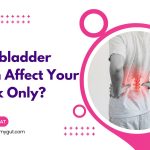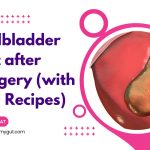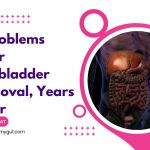5 First Signs of a Bad Gallbladder.
Our content is not intended nor recommended as a substitute for medical advice by your doctor. Use for informational purposes only.
The first signs of a bad gallbladder are nausea after eating, pain in the right upper quadrant or the middle of your abdomen, pain in the back of the right shoulder, and vomiting.
Keep reading to learn more about the first signs of a bad gallbladder.
1. Nausea after eating.
Nausea is one of the most common symptoms of gallstone disease. Severe nausea after eating fatty foods without significant stomach pain can be the first sign of a bad gallbladder.
Nausea is common with other gut diseases such as Acid reflux, chronic gastritis, peptic ulcer disease, and others. Although it is an important cause of nausea, the gallbladder is often overseen as a cause of nausea.
Nausea is isolated or associated with typical biliary colic (explained below). Isolated intense nausea after eating should raise the suspicion of a bad gallbladder.
2. Pain in the right upper abdomen.
Gallstones inside your gallbladder or biliary canal are divided into two categories:
- Uncomplicated gallbladder stones: often asymptomatic or present with occasional attacks of typical biliary colics (described in the table below).
- Complicated gallstone disease: either with acute cholecystitis (inflamed gallbladder with severe pain and fever) or obstruction of the bile ducts (manifested with jaundice).
Uncomplicated gallstones cause typical biliary colics (pain in the right upper abdomen), the first sign of a bad gallbladder.
The characteristics of a typical attack of gallbladder pain or biliary colic are in the table below (reference).
| Biliary colic (Uncomplicated gallstone). | Description |
| 1. Site | Usually, The right upper quadrant of your abdomen |
| 2. Spread | – The pain may spread to the back of the right shoulder. – Also, it spreads to the epigastric area. |
| 3. Character | Constant builds up then disappears gradually. |
| 4. Duration | At least 30 minutes. It may last up to 6 hours. |
| 5. Relation to food | – Triggered by foods (especially fatty food and large meals. – However, it can start spontaneously. |
| 6. NOT related to: | Movement, bowel movements, or the passage of flatus. |
| 7. Nausea | Often Present, severe. |
| 8- Commonly associated symptoms | Vomiting, sweating during the attack. |
| 6. Unusual symptoms. | – Heartburn and chest pain. – Bloating, fullness. – Early satiety. – Isolated epigastric pain. |
| 6. Symptoms NOT associated: (Complicated gallbladder disease). | – Fever. – Jaundice. – Prolonged pain for more than 6 hours. – Extreme tenderness over the gallbladder (Murphy’s sign). – Vomiting of blood, blackish stool (PUD). |
More:
- 5 Mimics of Gallbladder Pain.
- Do gallstones cause urinary problems or affect kidney function?
- 3 Common Gallbladder Sepsis Symptoms.
3. Pain in the middle-upper abdomen (epigastric pain).
The gallbladder can present with epigastric (upper central) abdominal pain. The central type of pain occurs with or without right-upper abdominal pain.
After eating, the epigastric pain is often attributed to stomach and esophageal problems such as gastritis and acid reflux.
Although not common, epigastric pain can be an early sign of a bad gallbladder. The main difference between gallbladder and stomach pain are:
- The gallbladder pain is often shorter (lasting an hour or two, with a maximum of 6 hours).
- Gastritis or peptic ulcer pain is often more prolonged for days or weeks.
- The gallbladder pain is often dull constant, and squeezing in nature, while epigastric pain is often burning or gnawing.
- Epigastric gallbladder pain is often associated with right upper abdominal pain or pain in the back of the right shoulder.
- The epigastric area is often completely free from attacks of pain when the cause is the gallbladder. On the other hand, the stomach pain is often more continuous (only decreases in intensity between the episodes of severe pain).
4. Pain at the right shoulder blade.
The pain from the gallbladder often refers to the right shoulder blade. The association between right upper abdominal pain and right shoulder blade pain highly suggests a bad gallbladder.
Consult your doctor if you constantly experience pain at the back of your right shoulder after eating. It can be the first sign of a bad gallbladder.
5. A sense of stomach fullness after eating.
Being unable to complete your meal (early satiety) or feeling full after eating can be the first signs of a bad gallbladder.
Most of us attribute early satiety and fullness to indigestion or functional dyspepsia. However, the two symptoms can be a presentation of gallbladder disease, especially if you have risk factors for gallstones such as:
- Obesity.
- Being a female.
- History of rapid loss of weight.
- Fatty or junk food.
- Positive family history of gallstones.
- The risk increases with age.
6. Bloating and abdominal distension.
The bile secreted from the liver is stored in the gallbladder and then reaches the duodenum (The first part of your small intestine). The primary function of bile is to help digestion and absorb fat and fat-soluble vitamins.
When your gallbladder is affected, fat digestion and absorption can be altered. As a result, fat indigestion can cause bloating and abdominal distension.
Constant bloating and gas distension (together with diarrhea) can be the first signs of a bad gallbladder.
7. Changes in bowel habits (diarrhea).
Gallbladder malfunction affects your bowel habits. A common example is bile acid diarrhea, characterized by diarrhea with severe urgency (reference).
Bile acid diarrhea (BAD) is a common disease. Moreover, it is often misdiagnosed as IBS-diarrhea while the cause is bile.
Interestingly, several studies (reference 1, reference 2) found that almost 50% of people with IBS-D (Irritable Bowel syndrome-predominant diarrhea) have Bile Acid Diarrhea(BAD).
So, a change in bowel movements (particularly diarrhea) can be the first sign of a bad gallbladder.
Learn More about Bile acid diarrhea
MORE: 5 Main Causes of Lack of Bile in Stool.
8. Silent gallbladder stones.
Asymptomatic gallstones are common. Asymptomatic gallstones are found in (reference):
- 5% of females aged 20-29 years.
- 9% of females aged 30-39 years.
- 11% of females aged 40 years or more.
- Gallstones are rare in males aged less than 40 years. But its risk increases with age.
So, A bad gallbladder can have no signs at all. In such cases, the gallstones are often discovered accidentally. Commonly during an ultrasound or CT examination of the abdomen.
MORE: Is there a Test For gallstones At home?
- Evidence-based
- Written by a doctor.

Related Posts:
- Can Gallbladder Pain Affect your Back Only?…
- 8 Warning Signs of a Dying Liver (Hepatologist Explains).
- IBS Yellow Stools: Is It A Normal Or A Bad Sign?
- What Are The Signs Of A Perforated Bowel After A…
- 6 Causes of Bigger Stomach after Gallbladder Surgery…
- Pancreas Problems: 5 Main Conditions, Symptoms, & Signs






